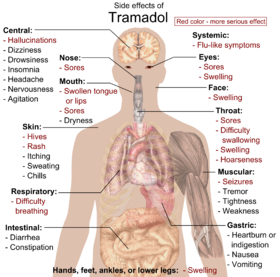Ultram®) is a prescription medication licensed for the treatment of pain. Specifically, tramadol benefits include treating moderate to moderately severe pain in adults (age 16 and older).
Tramadol is classified as a "centrally acting opioid analgesic." This means that it works in the central nervous system (the brain and spinal cord), acts much like morphine in the body, and relieves pain. Tramadol also works in a similar manner as someantidepressant medications by inhibiting the reuptake of certain brain chemicals (serotonin and norepinephrine).
Originally, tramadol was marketed as a medication with weak narcotic effects and little potential for abuse. However, research has since demonstrated that this drug works primarily through morphine-like activity, and numerous cases of abuse and dependence have been reported.
Throughout all the clinical trials and the accumulating years of experience after launch, Tramadol has proved a remarkably reliable and effective painkiller:
- it treats and relieves pain no matter what the cause;
- it works equally well across the age range from 16 years upwards although the dosage may be changed to reflect different body weights;
- there’s no difference in its effectiveness in all the different races;
- it’s equally effective in both sexes;
- there are side effects but, in most people, they last only a short period of time and are not serious; and
- there’s only a low level risk of it proving habit-forming.
SIDE EFFECTS
Tramadol Side Effects: Brand name Ultram. Tramadol is available as 50 and 100 mg dose tablets. There are also sustained release formulations, and formulations that also contain acetaminophen. Tramadol is a synthetic opioid-like drug that has its effects primarily as an agonist (stimulator) of the mu opioid receptor site. Tramadol is used primarily for moderate to severe pain control. It has many properties in common with other opioid medications, but is different in that it acts more specifically on the opioid mu receptor than most other opioids. (there are other opioid receptors) Like other opioids is potentially habit forming, although some experts feel this is a less severe and common problem with tramadol than with other opioids. Tramadol is also used for treatment of restless legs syndrome and fibromyalgia, and has additional properties that affect neurotransmitter release and reuptake.
Common Tramadol Side Effects: Tramadol side effects include many of the gastrointestinal side effects of opioid agonists including constipation, nausea, vomiting, dyspepsia and occasionally diarrhea. These are due to the opioid mu receptors in the GI tract that lead to increased stimulation of the circular muscles and decreased stimulation of the longitudinal muscles of the colon wall. This leads to poor propulsive effect of the bowel content and increased churning of the bowel content, and caused dryer and firmer stool, and slower transit time. It can also lead to decreased feeling of fullness in the distal colon and reduced urge to defecate. Non GI tramadol side effects that are common include somnolence, itching, dizziness, sweating and flushing.
Life Threatening Tramadol Side Effects: Seizures are the most important tramadol side effect to consider. They are more common in people with a history of seizures, and if you have a history of seizures you should be sure your physician knows about this history, and if used tramadol dosing should be minimized. The other serious side effects can be primarily grouped into the allergic side effects including angioedema, anaphylaxis, severe rashes including the Stevens-Johnson Syndrome and toxic epidermal necrolysis, and those side effects shared with most opioids including withdrawal syndrome if discontinued suddenly, dependency and abuse, respiratory depression, and depression/suicide Other serious tramadol side effects can be the serotonin syndrome, and orthostatic hypotension (drop in blood pressure on sitting or standing)
Unusual Tramadol Side Effects: Seizures are the most unusual tramadol side effect that is occasionally seen.
Drug Interactions: Tramadol is contraindicated for use with alcohol (don’t drink alcohol while taking tramadol), some HIV drugs, and any MAO inhibitors (mono-amine oxidase inhibitors) Tramadol is metabolized extensively in the liver using the cytochrome P-450 pathway including several specific enzyme processes (2B6, 2D6, and 3A4). This leads to many drug interactions including bupropion, digoxin, warfarin and such a long list of other medications that it is not realistic to discuss them all here. Refer to the manufacturers prescriber information for more details.
Pregnancy and Lactation Class: Tramadol is pregnancy Category C and is considered possibly unsafe in lactation.
Special Considerations: Tramadol is generally considered to be less addicting than many other opioid analgesics, but it is still an opioid mu receptor and has the potential for abuse. Do not share this medication with others, and certainly do not crush the pills for inhalation or injection. Seizures are the unique tramadol side effect and is especially a concern if used taken in higher than the recommended dosage or if you have a history of seizures.

